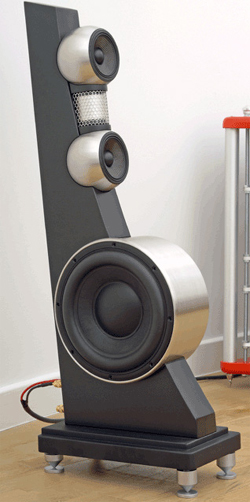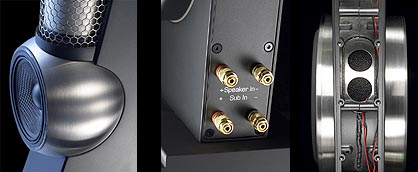You are reading the older HTML site
Positive Feedback ISSUE
18
march/april 2005
gallo
Reference 3 loudspeakers
as reviewed by Danny Kaey

|
DANNY KAEY'S SYSTEM
LOUDSPEAKERS
ELECTRONICS
SOURCES
CABLES
|
It seems that everyone is getting into the loudspeaker business. Every month, when new audio magazines arrive on my doorstep, I get to check out at least one new speaker system. Of course, audio wouldn't be audio without each of these manufacturers claiming to have introduced the next revolution in loudspeaker design, and of course the next "Best in class—sounds better than speakers costing five times as much," etc. I find these comparisons trivial, as there is no realistic way to do that kind of cost analysis without knowing more about the companies in question. How much overhead do they have? How many employees? How much money do they spend on advertising and marketing? Each of these parameters will be reflected in the retail price of the components being compared—loudspeakers, amplifier, or otherwise.
To add icing to the cake, China has become the new haven for manufacturing. Wages in China are very low, yet its manufacturing capabilities rival anything the West has to offer and then some. China realized that the only way it could compete in the world market was through a free enterprise system, focusing on a multitude of products. It is only natural for audio manufacturers to turn to China. Profit margins can be vastly increased, even if price points are lowered, if you pay a worker $25 a week vs. $25 an hour in the good ol' US of A (or any European country). If a product made here sells for $1000, it could probably be made in China and sold for $100. Hence, you can't make general statements like "This amp sounds better than amps costing five times as much." We have become too entrenched in our view that more money tends to mean better performance.
This attitude is flawed. A good design does not have to be expensive. Conversely, are Wilson Audio WATT/Puppy 7 loudspeakers (to take just one example) really worth $24,000? Sure, the company prides itself on its cabinet materials and its superb automotive-based paint finishes, but let's be realistic. I can go to my local auto supply store and buy a bucket of Mercedes paint for a heck of a lot less than what Wilson charges for their paint job. In fact, a Mercedes restoration place (I own a 66' 250 SE that needs restoration, and is a work in progress) quoted me $500 per speaker to get my Marten Design Miles IIs finished in any Mercedes color I desired, with the most impeccable finish to boot. (This shop restores such classics as the Gullwing Mercedes.) So let's see: $10,000 for the Miles (retail) plus another $1000 for the finish and voila, I have a pair of loudspeakers that would give any pair of Wilsons a run for their money, at about half the cost. Of course, many audiophiles would disagree with me, but again, let's be sensible. Much of a speaker's price is derived from the many hours it takes to design and manufacture it. Wood is expensive to work with, and finding good cabinetmakers is even more challenging and expensive. If someone were to design a speaker that didn't rely on woodwork, they could offer a true winner at a substantially lower price than the competition.
Enter Anthony Gallo. Although he has been around for quite some time, I have only recently become familiar with his products, and couldn't resist the idea of reviewing his statement loudspeakers, the Reference 3s. Shortly after last year's CES, I began to hear rumors about groundbreaking loudspeakers from Gallo Acoustics that were the rave of the show. When I found out that PFO had received a pair, I grabbed the phone, anxious to get myself in line for a review. After Victor and Fo were done with them, it was my turn (read their review here). The first thing that impressed me was the amount of care Gallo took to ship the speakers. This was the first time I had received a pair of speakers in their own flight cases! Each case was about the size of my 11-year-old daughter! It was obvious that Gallo cared about shipping to and from reviewers. (I found out later from JD, Gallo's US sales and marketing guru, that the speakers are not normally shipped in flight cases, as that would be too expensive. They do, however, come in sturdy cardboard boxes with heavy-duty foam inserts.)
Lugging these 80-pound monsters to my second-floor apartment proved to be quite the task, but I knew it would be worthwhile, since anyone who protected their investment with this much care must have something really special going on. Opening the cases, I felt as though I was about to unravel Tutankhamen's last mystery. The little R3S were almost lost inside those gargantuan cases, but lo and behold, before me lay slim and superbly sculpted wonders of modern metal machining. I couldn't help but be amazed at these avant-garde-looking, space-age loudspeakers. I have a sweet tooth for off-the-wall, cool and different looking pieces of gear, and the Gallos fit right into that niche. Gallo, knowing that some consumers would find the "naked" look a bit stark, provides sharp black see-through hoods for them. The hoods fit over the entire speaker, and instantly transform them from spacey-looking UFOs to more conventional box type loudspeakers—a nice touch. Also part of the package are four sets of precision cut aluminum cones, in two different lengths. Since the speakers are so diminutive, they need to be tilted back a bit in order for the tweeter to reach the appropriate ear height. You simply mount the shorter cones in the rear of the speakers and the longer ones in front, then adjust them to align the tweeters with your ears.

Speaking of the tweeters, quite a bit of care was taken in the design of these nearly omni-directional drivers. Their effective dispersion is 300 degrees, and the proprietary material used is extremely thin, resulting in an effortlessly quick response time. The top end of these very resolving, super-quick tweeters extends to 50kHz, which means that they work to the full benefit of the latest high-res software—SACD and DVD-A—as well as vinyl, without the need to add supertweeters. In addition, the speakers feature a switch that allows fine-tuning of the high frequencies to your room, with settings at 0dB, +2dB, and -2dB. In my case, the proper setting was at -2dB. One small caveat is that you must take the utmost care to ensure that the tweeters' horizontal axis is at ear level. Any deviation from the optimal position results in a loss of high-frequency information and smearing of the musical image. Tape fans should think of it in terms of azimuth alignment. If it's correct, the sound is fully extended, otherwise it's dull and lifeless.
The midrange of each speaker is handled by two carbon fiber drivers that flank the tweeter in a DiAppollito array. Gallo chose this material to match the speed and agility of the tweeter. The low frequencies are handled by a massive 10-inch driver of a dual-voice-coil, long-throw design. The woofers extend the R3s' low frequencies to the mid 30s, and they can be lowered a further half-octave with an additional voice coil amplifier. (Unfortunately, Gallo was still putting the final touches on this amplifier, so I was not able to try it. The amp should be available around April.) Due to the layout of the R3s, you can have the woofers facing either inside or outside, depending on your room.

It is obvious that a lot of care went into the design of the R3s. It is hard to find many of these features in any speaker, let alone one that retails for $2599! Gallo chose to put all of his knowledge and experience into a small, affordable speaker, and this is a good thing for consumers. Before spending some quality time with the R3s, I noted that both Fo and Victor had noticed a slight veil in the midrange and recessed imaging. I sent an email to Anthony Gallo, who cleared up the issue right away. The R3s need serious burn-in time—serious in the amount of wattage being applied, rather than the length of time needed. Gallo claims that more than 95dB output for as little as 20 hours should do the trick. He also claims that many consumers will never hear the full potential of the R3s in a dealer demo because few dealers will give them enough break-in time. The differences can be fairly dramatic, so if you schedule a demo, make sure that the dealer has given the speakers the break-in they need.
After I expended a great deal of effort making sure that the R3s were positioned properly and that the tweeters were in line with my listening position, the first comment I made on my notepad was that they had a very nice high end. The treble was airy and extended, yet did not have that typically shrill, over-pronounced treble that many listeners mistakenly take for granted. No doubt this is an achievement of the special tweeters, which never draw attention to themselves, as if to say, "Hey, look at me, look what I can do!" I have heard many speakers that do exactly that, yet for some reason they remain ever so popular among reviewers and consumers. In my opinion, nothing is worse than fake resolution or ersatz highs. The Gallos manage to draw you into the music without these side effects. Take, for example, some of the new Mercury Living Presence SACD or the (outstanding!) Speakers Corner LP reissues. Why do I mention these recordings? Tape hiss! You can judge the performance of a speaker based on listening to tape hiss alone. Unlike the people who think tape hiss is a no-no, I look at it as a function of the performance.
 On the fabulous Speakers Corner (Mercury) LP of the
Rachmaninov Piano Concerto 3, the sound of the piano and accompanying orchestra
was nothing short of spectacular. In the sections in which tape hiss was
noticeable, I could almost smell the tape being spooled past the heads. The
piano, a particularly difficult instrument to reproduce accurately, was
portrayed with its full, fantastic impact. Each note was clearly outlined and
emerged from space, floating in mid air. No speaker of recent memory has been
able to so convincingly recreate a nearly 360-degree sound field. With the
appropriate material I truly felt part of the performance, as if by some magic I
suddenly had a surround-sound system. Yello's latest release, The Eye, is a
fantastic test of this. The album sizzles with spectacular images, spatial
effects, and a soundstage that—with the appropriate speakers—becomes a wall of
sound. The Gallos were able to throw a soundstage so vast and deep that it
cracked open the boundaries of my listening room. The track "Time Palace" is a
perfect example of Yello's stunning arrangement abilities. If ultra-cool
electronic music is your forte, crank this track. It is nothing short of jaw
dropping.
On the fabulous Speakers Corner (Mercury) LP of the
Rachmaninov Piano Concerto 3, the sound of the piano and accompanying orchestra
was nothing short of spectacular. In the sections in which tape hiss was
noticeable, I could almost smell the tape being spooled past the heads. The
piano, a particularly difficult instrument to reproduce accurately, was
portrayed with its full, fantastic impact. Each note was clearly outlined and
emerged from space, floating in mid air. No speaker of recent memory has been
able to so convincingly recreate a nearly 360-degree sound field. With the
appropriate material I truly felt part of the performance, as if by some magic I
suddenly had a surround-sound system. Yello's latest release, The Eye, is a
fantastic test of this. The album sizzles with spectacular images, spatial
effects, and a soundstage that—with the appropriate speakers—becomes a wall of
sound. The Gallos were able to throw a soundstage so vast and deep that it
cracked open the boundaries of my listening room. The track "Time Palace" is a
perfect example of Yello's stunning arrangement abilities. If ultra-cool
electronic music is your forte, crank this track. It is nothing short of jaw
dropping.
Not a Yello fan? Try Steve Hoffman's new Nat King Cole release on S&P Records instead. You will wonder how Gallo is able to make this level of performance available for such a low entrance fee. The issues that Fo and Victor had with the R3s—midrange veiling and smearing—were all but absent in my setup. The transition from mids to highs was smooth. On Billy Holiday's Songs for Distingue Lovers on the Classic Records 45 rpm cut, her voice sounded amazing. I was able to play virtually any Frank Sinatra record and listen to Ol' Blue Eyes' way with rhythm. It was easy to see why he became the quintessential male vocalist. On lesser speakers, his voice can break up and sound congested. Not so with the R3s. They never sounded less than spectacular. I was amazed at the level of excitement you can get for less than $3000!
The bass performance of the R3s was the only area in which I can criticize them. Whether I faced the woofers inside or out, I simply could not get great bass. No matter what I did, it sounded somewhat slow and bloated on all material. On a favorite bass test, "Die Another Day," Madonna's superb title track from the last James Bond movie soundtrack, the bass seemed out of touch with the rest of the music. Bass notes seemed to wander, never really hitting the sweet spot. The effect was perhaps less evident when I faced the R3s outwards, though the bass performance was still not anywhere near the performance of the rest of the speakers, especially the tweeters. After I borrowed some room treatment panels, the bass notes sounded more defined, but they still seemed to lag. Kind of Blue was no different. The standup bass had visceral impact—keep in mind that we are talking about two 10-inch drivers—but the emotional connection was missing. It seemed as though the bass was plucked, but the note didn't strike until a microsecond later. It is possible that this was due to a lack of power on the part of my E.A.R. 890 amplifier, and not the R3s (I also have a rather large squar-ish room with wood floors which may be causing some issues with the bass). Besides, the voice coils of the R3 woofers would probably rather have, say, a 300-watt solid-state monster amp than a 70-watt tube amp. Nevertheless, this was the first time I suspected that the 890 was unable to properly control the bottom end of a loudspeaker.
Using the the awe-inspiring Velodyne DD-15 subwoofer to "augment" the R3s was like flicking an insanely powerful switch. Suddenly and dramatically, the bass performance of the system was transformed from okay to exceptional. Particularly when utilizing the Velodyne's 80Hz high pass filter, the Gallos really began to dance. The bass problems disappeared, and images sounded even more dramatic and authoritive. "Die Another Day"? Come on over and be prepared to be hit with a hammer. I always debate the usefulness of employing a subwoofer, particularly the one-of-a-kind Velodyne, in reviewing loudspeakers. The speakers should be able to give you an insight into the music without assistance, but this was not so with my setup, as the addition of the Velodyne transformed the Gallos. Let's keep in mind, however, that the DD-15 costs $4000—quite a bit more than the R3s. It was no surprise that adding this behemoth gave the results I heard.
The Gallo Reference 3s are exceptional loudspeakers. Some of the qualities I experienced with them have not been replicated by any other speakers that I have had the pleasure of spending time with—in many cases ones that cost several times as much. Again note that the R3s must be broken in properly or this level of performance will not be attainable. I am willing to bet that anyone who puts up a pair of R3s for sale after only a short listening period is suffering from that problem. Gallo should make sure that future owners are aware of it. If you are looking for class-transcending performance, look no further than the R3s. At $2599, these loudspeakers are better than they have any right to be. Heck, I would recommend them even if they cost quite a bit more! I can only wonder what Gallo would be able to achieve if he were to design an all-out speaker for, say, $10K? Danny Kaey
Reference 3 loudspeakers
Retail: $2600 pair
Anthony Gallo Acoustics
web address: www.roundsound.com
